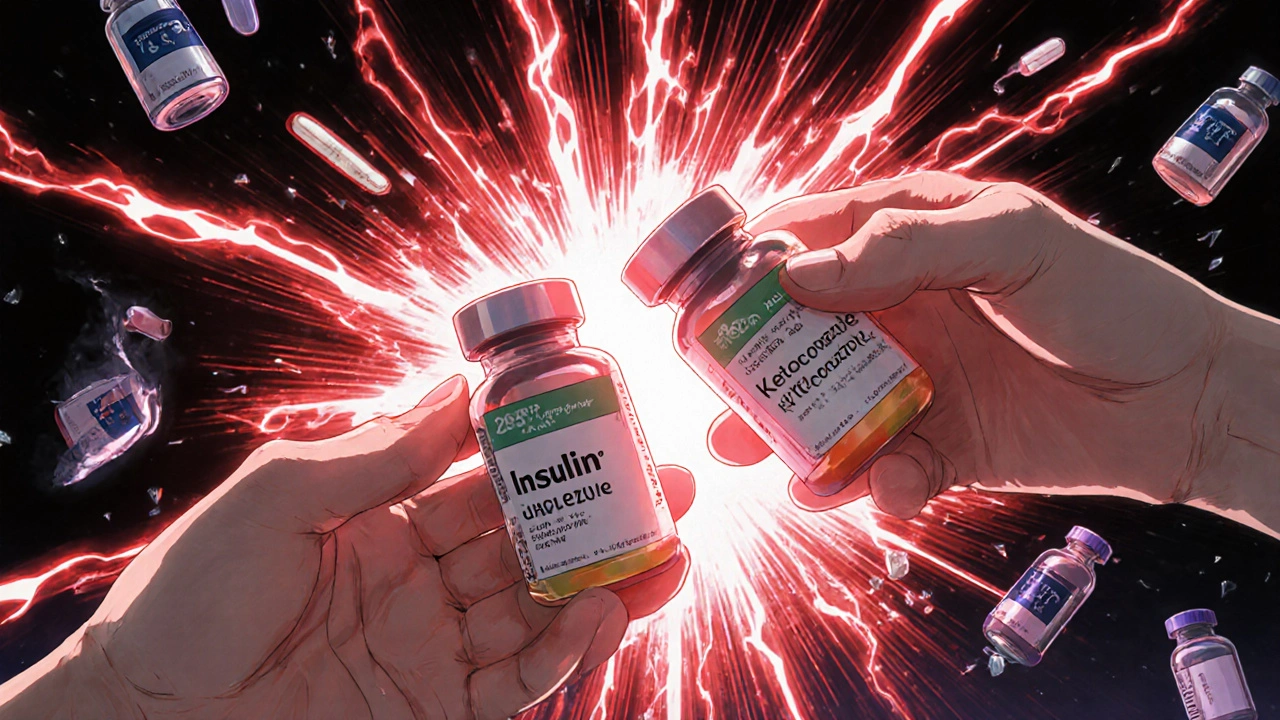Combining diabetes medications might seem like a smart way to get blood sugar under control, but some mixes can be dangerous-sometimes life-threatening. It’s not just about taking more pills. It’s about how those pills talk to each other inside your body. A simple combo like insulin and a common antifungal can send your blood sugar crashing. Another mix might leave you with swelling, heart strain, or unpredictable spikes. The diabetes drug interactions you don’t know about could be the reason your numbers won’t stabilize, even when you’re doing everything right.
Why Some Diabetes Drugs Don’t Play Nice
Not all diabetes medications work the same way. Some boost insulin, some help your body use insulin better, others push sugar out through your kidneys. But when two or more of them overlap in how they’re processed, things go wrong. Most interactions happen because of liver enzymes-especially CYP3A4, CYP2C8, and CYP2C9. These enzymes break down drugs so your body can get rid of them. If one drug blocks or slows down that enzyme, the other drug builds up in your system like a traffic jam.Take sulfonylureas like glipizide or glyburide. They’re older, cheap, and effective-but they’re also highly sensitive to enzyme blockers. If you’re on one of these and start taking an azole antifungal like ketoconazole for a fungal infection, your body can’t clear the sulfonylurea fast enough. That means too much insulin gets released. Result? Severe, sudden hypoglycemia. You might feel dizzy, sweaty, confused-or worse, pass out. This isn’t rare. Emergency rooms see this combo often, especially in older adults on multiple meds.
The Insulin and Rosiglitazone Trap
Rosiglitazone (Avandia) isn’t used as much these days, but some people still take it. It’s a thiazolidinedione that makes your body more sensitive to insulin. Sounds good, right? But when you add insulin on top of it, the effect multiplies. Your body absorbs more glucose into muscles and fat-and holds onto fluid. That’s why this combo increases the risk of heart failure and dangerous swelling in the legs, ankles, and lungs.The American Diabetes Association doesn’t outright ban this combo, but they strongly discourage it. If you’re on insulin and your doctor suggests adding rosiglitazone, ask: Is this really necessary? Are there safer options? There are. Newer drugs like GLP-1 receptor agonists (liraglutide, semaglutide) work better, with fewer side effects and less risk of fluid retention. They also help with weight loss, which insulin alone doesn’t do.
When Antibiotics and Antifungals Turn Against You
It’s easy to forget that infections need treatment too. But if you have diabetes and catch a fungal infection or a stubborn bacterial bug, the meds you take for it can interfere with your diabetes control. Azole antifungals-ketoconazole, itraconazole, fluconazole-are big culprits. They block CYP3A4 and CYP2C9, which are the same enzymes that clear meglitinides like repaglinide and nateglinide.Repaglinide is especially vulnerable. Studies show that when taken with ketoconazole, its blood levels can spike by over 200%. That means your pancreas dumps out way more insulin than it should. A single dose of this combo can trigger hypoglycemia within hours. Even fluconazole, often seen as milder, can cause dangerous drops in blood sugar if you’re on repaglinide.
Antibiotics like clarithromycin and erythromycin (macrolides) do the same thing. They’re common for chest infections, sinusitis, or skin issues. If you’re on a meglitinide and your doctor prescribes one of these, ask if there’s an alternative. Azithromycin is usually safer. Don’t assume your pharmacist flagged it-many don’t catch these interactions unless they’re specifically looking.

Metformin and Kidney Trouble
Metformin is the first-line drug for type 2 diabetes. It’s safe for most people. But it’s cleared by the kidneys. If your kidney function drops-even slightly-metformin can build up. That raises your risk of lactic acidosis, a rare but serious condition where your blood becomes too acidic.What makes this worse? Other drugs that also stress the kidneys. Diuretics like furosemide, NSAIDs like ibuprofen or naproxen, and contrast dyes used in CT scans can all reduce kidney flow. If you’re on metformin and get prescribed one of these, your doctor should check your eGFR (kidney function test) before and after. If your eGFR falls below 30, metformin should be stopped. Between 30 and 45? Use the lowest dose and monitor closely.
Even something as simple as dehydration from a stomach bug can push you over the edge. If you’re on metformin and get sick, stop the drug until you’re eating and drinking normally again. Don’t wait for your doctor to tell you-this is something you can act on.
GLP-1 RAs and SGLT-2 Inhibitors: The Safer New Players
The good news? The newer diabetes drugs have fewer interactions. GLP-1 receptor agonists (like semaglutide, dulaglutide) and SGLT-2 inhibitors (like empagliflozin, dapagliflozin) work differently. They don’t rely on liver enzymes as much. They’re not broken down by CYP450 systems. That makes them much more predictable when mixed with other meds.That’s why guidelines now recommend combining GLP-1 RAs with insulin instead of adding more sulfonylureas or meglitinides. You get better blood sugar control, less weight gain, and lower hypoglycemia risk. SGLT-2 inhibitors pair well with almost everything-even metformin. They don’t cause low blood sugar on their own, and they protect the heart and kidneys.
There’s one combo to avoid, though: DPP-4 inhibitors (like sitagliptin, linagliptin) with GLP-1 RAs. They do the same thing-boost GLP-1 activity. Putting them together gives you no extra benefit, just more cost and more side effects like nausea or diarrhea. The ADA says outright: don’t do it.

Hidden Risks: Steroids, Diuretics, and Quinine
Sometimes the danger isn’t from another diabetes drug. It’s from something you’re taking for something else.Corticosteroids-prednisone, dexamethasone-are common for asthma, arthritis, allergies, or autoimmune diseases. But they make your liver pump out more glucose. If you’re on insulin or sulfonylureas, your dose might need to go up during steroid treatment. Your blood sugar can spike overnight. You might need to check it more often-three or four times a day-until the steroid course ends.
Diuretics like hydrochlorothiazide can also raise blood sugar. They’re used for high blood pressure, but they interfere with insulin release. If your sugar starts creeping up after starting a diuretic, don’t assume it’s just aging. Talk to your doctor about switching to a different blood pressure med, like an ACE inhibitor or ARB, which are safer for diabetics.
And then there’s quinine. Yes, it’s in tonic water-but in high doses, it’s used for leg cramps. Quinine can cause severe hypoglycemia, even in people not on diabetes meds. If you’re taking insulin or sulfonylureas and drink a lot of tonic water, or take quinine pills, your blood sugar can drop dangerously low. It’s rare, but it’s documented in case reports. Skip the tonic water if you’re on insulin.
What You Should Do Right Now
If you take more than one diabetes medication-or any other regular prescription-here’s what to do:- Make a full list of everything you take, including supplements, OTC painkillers, and herbal products.
- Bring it to your doctor or pharmacist every time you get a new prescription.
- Ask: “Could this interact with my diabetes meds?” Don’t assume they’ll catch it.
- Check your blood sugar more often when starting a new drug, especially in the first week.
- If you feel unusually tired, shaky, confused, or overly thirsty-test your sugar. Don’t wait.
There’s no shame in asking questions. These interactions are complex, even for doctors. Your job isn’t to know all the science-it’s to know your body and speak up when something feels off.
What’s Changing in 2025
New research is looking at how drug transporters-like P-glycoprotein-affect how diabetes drugs move in and out of cells. DPP-4 inhibitors might be affected by drugs that block this transporter, which could change how they interact with antibiotics or heart meds. This is still being studied, but it’s another reason why you can’t assume older interaction lists are complete.Guidelines are shifting too. The American Diabetes Association now recommends GLP-1 RAs as first-line for many people with type 2 diabetes, especially if they have heart or kidney disease. That’s because they’re not just safer with other drugs-they actually protect your organs. The future of diabetes care isn’t about stacking pills. It’s about choosing smarter combinations that work with your body, not against it.
Can I take metformin with ibuprofen?
Taking metformin with ibuprofen or other NSAIDs can reduce kidney function, which raises the risk of lactic acidosis. If you need pain relief, acetaminophen (paracetamol) is safer. If you must use ibuprofen, keep your dose low, stay hydrated, and ask your doctor to check your kidney function regularly.
Is it safe to combine insulin and GLP-1 receptor agonists?
Yes, this is one of the safest and most effective combinations for type 2 diabetes. GLP-1 RAs help your body release insulin only when needed, reduce appetite, and lower the risk of low blood sugar compared to adding sulfonylureas. Many people on this combo see better blood sugar control, weight loss, and less hypoglycemia than with insulin alone.
Why should I avoid DPP-4 inhibitors with GLP-1 RAs?
Both drug classes work by increasing GLP-1 activity in your body. Combining them doesn’t give you better blood sugar control-it just increases side effects like nausea, vomiting, and diarrhea. The American Diabetes Association specifically advises against this combo because there’s no benefit and extra cost.
Can antifungals cause low blood sugar with diabetes meds?
Yes, especially azole antifungals like ketoconazole and itraconazole. They block liver enzymes that break down meglitinides (repaglinide, nateglinide) and sulfonylureas, causing these drugs to build up and trigger severe hypoglycemia. Always tell your doctor you have diabetes before starting any antifungal.
What should I do if I start a new medication and my blood sugar changes?
Check your blood sugar more often-especially before meals and at bedtime-for the first week. If your numbers are consistently high or low, contact your doctor. Don’t adjust your diabetes dose on your own. Bring your logbook or app data to your appointment. Small changes in meds can have big effects, and timing matters.




Gina Damiano
October 31, 2025 at 22:38I was on glyburide for years and never knew ketoconazole could tank my blood sugar like that. My doc just prescribed it for a yeast infection and I felt like I was going to pass out at work. Turned out my sugar was 38. I thought I was just tired. Never again. Always ask about interactions. Seriously.
Emily Duke
November 2, 2025 at 20:50OMG, I JUST HAD THIS HAPPEN!!! 😭 I took fluconazole with repaglinide and woke up in a cold sweat at 3am thinking I was dying. My husband had to give me juice. I didn’t even think to check my sugar because I thought it was just anxiety. I’m so mad at my pharmacist for not saying anything. This needs to be on every prescription label. Like, PLEASE.
Stacey Whitaker
November 3, 2025 at 12:07Metformin and ibuprofen? I’ve been doing that for years. My knees hurt. I didn’t think twice. Now I’m scared. Maybe I should switch to Tylenol. My doctor never mentioned it. I guess I assumed if it was over the counter, it was safe. Guess not.
Kayleigh Walton
November 4, 2025 at 22:44This is such an important post-and honestly, it’s something every person with diabetes should read, even if they think they’re doing everything right. I’ve seen too many patients panic because their numbers are off and they don’t realize it’s a new antibiotic or a steroid for their allergies. The key is communication. Keep a list. Bring it to every appointment. Ask the question: ‘Could this mess with my diabetes meds?’ No one expects you to know the science. Just know your body and speak up. You’re not being annoying-you’re protecting your life.
Also, GLP-1 RAs with insulin? That’s the gold standard now. So much better than piling on more sulfonylureas. Weight loss, less hypoglycemia, heart protection-it’s a win-win. If your doctor isn’t talking about these options, ask why.
And yes, skip the tonic water if you’re on insulin. I know it’s trendy, but that quinine? Real risk. I had a patient who drank three glasses a night for leg cramps. One night, she crashed. No one knew why. Turns out, it was the tonic. We stopped it. She’s fine now.
You’re not alone in this. Many of us are learning as we go. But you’re doing the right thing by paying attention. Keep going.
Stephen Tolero
November 6, 2025 at 16:42The CYP3A4 inhibition mechanism is well-documented for azoles and meglitinides. However, the clinical significance varies based on renal and hepatic function. Not all patients will experience severe hypoglycemia. Individual pharmacokinetics matter.
Brooklyn Andrews
November 7, 2025 at 02:03Ugh. I just got prescribed prednisone for my eczema and my sugar’s been through the roof. My doctor said ‘just increase insulin.’ No mention of checking more often or watching for crashes later. I’m just supposed to wing it? This post is a wake-up call. I’m printing it out and bringing it to my next appointment. No more assumptions.
Joanne Haselden
November 8, 2025 at 11:05As a diabetes educator, I can’t stress this enough: polypharmacy is the silent killer in type 2 diabetes. We focus so much on HbA1c and weight that we overlook the drug-drug interactions that are literally hiding in plain sight. The CYP450 system isn’t just a biochemistry lecture-it’s a clinical minefield. And the newer agents? GLP-1 RAs and SGLT2 inhibitors aren’t just ‘better’-they’re paradigm-shifting. They reduce cardiovascular mortality. That’s not a side effect. That’s a therapeutic win. We need to stop treating diabetes like it’s 2005. The guidelines changed. We need to catch up.
Also-DPP-4 + GLP-1 RA? That’s like putting two GPS apps on your phone at once. They’re both trying to guide you, but you’re just getting duplicate signals and draining your battery. No benefit. Just nausea and $$$.
Vatsal Nathwani
November 10, 2025 at 05:24Why are people so scared of pills? Just take one thing at a time. Stop overcomplicating. I’ve been on metformin for 10 years and I take ibuprofen when I need it. Nothing happened. Stop scaring people.
Saloni Khobragade
November 10, 2025 at 22:59I read this and I’m so mad. My cousin died from lactic acidosis after taking metformin with ibuprofen. She didn’t even know it was dangerous. Her doctor didn’t tell her. Now I’m telling everyone I know. You need to stop taking painkillers if you have diabetes. It’s not worth it. RIP cousin.
Sean Nhung
November 12, 2025 at 01:19So… insulin + GLP-1 RA = good 😊
Metformin + NSAID = risky 😬
Fluconazole + repaglinide = bad news 🚨
And tonic water? Skip it 🚫
Also… why does everyone keep forgetting about hydration? 😅
kat pur
November 13, 2025 at 01:19This is exactly the kind of information that needs to be shared. I’m not a doctor, but I’ve managed type 2 for 15 years, and I’ve learned the hard way that no one else is watching out for you like you are. I keep a printed list of every medication, supplement, and even herbal tea I take. I show it to every new provider. I check my blood sugar when I start anything new-even a cold medicine. It’s not paranoia. It’s responsibility. And if you’re reading this and you’re scared? You’re not alone. But you’re also not powerless. Knowledge is your best tool.